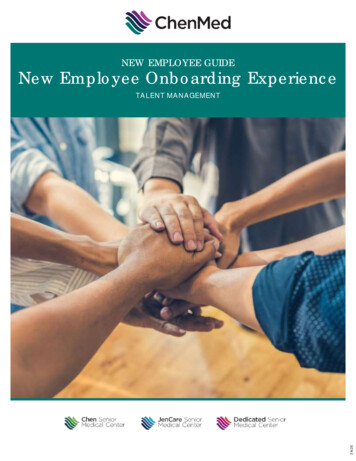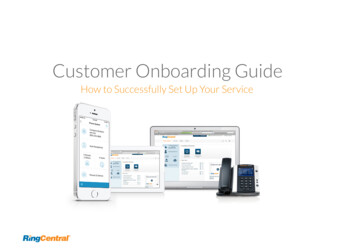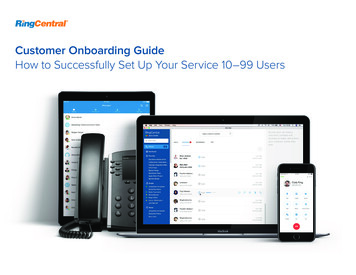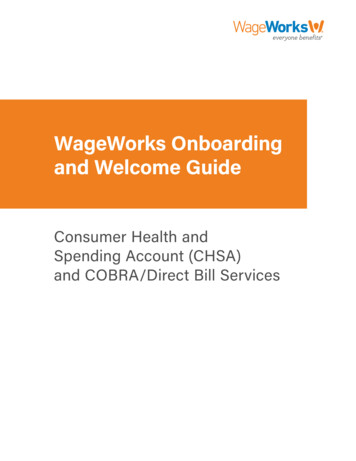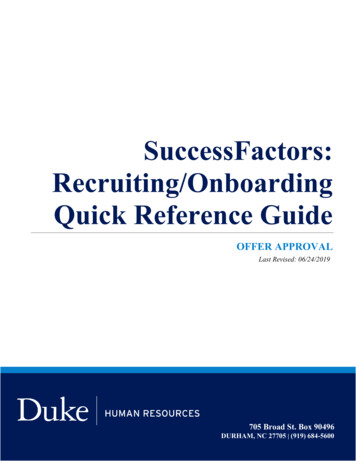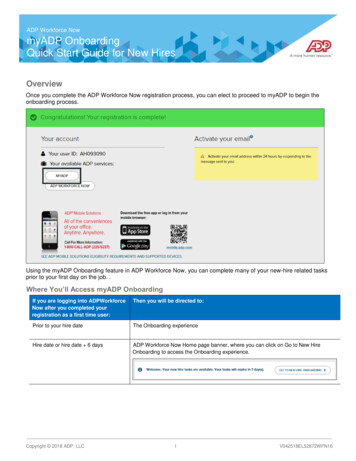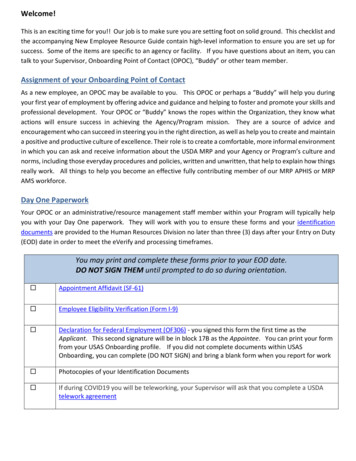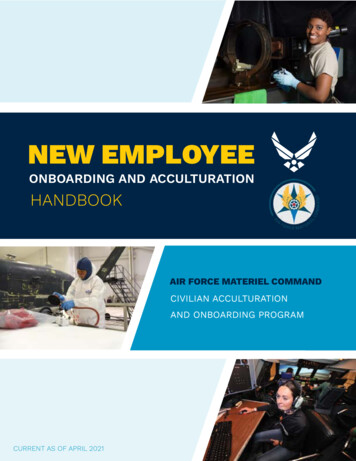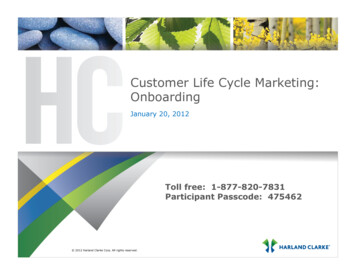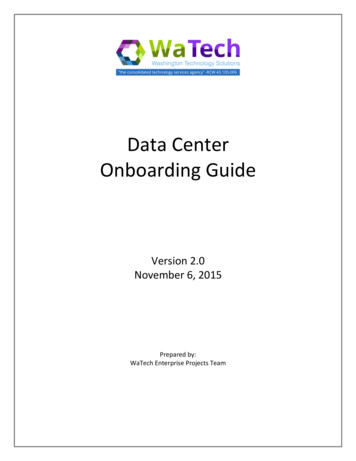
Transcription
Data CenterOnboarding GuideVersion 2.0November 6, 2015Prepared by:WaTech Enterprise Projects Team
ContentsDOCUMENT REVISION HISTORY . 3INTRODUCTION . 4PURPOSE OF THIS GUIDE . 5DOCUMENT STRUCTURE . 5ASSUMPTIONS . 6DATA CENTER ONBOARDING TASKS . 6APPENDIX A – REFERENCED DOCUMENTS . 22APPENDIX B – ONBOARDING CHECKLIST. 234REFERENCES. 2772
Document Revision HistoryDescription of ChangeFirst version (1.0)Minor revision (1.1)Minor revision (1.2)Minor revision (1.3)Minor revision (1.4)Minor revision (1.5)Minor revision (1.6)Major version (2.0)PageAllManyMany9, 1310-15,21Many18-20All3Date /8/1411/11/15ReviserTeamNyaNyaNyaTeamTeamHeidiTeam
IntroductionSince the 1960s the state of Washington has grown its information technology infrastructure in supportof state business operations. Over this span of time, many data centers were opened across ThurstonCounty. During the 2009 legislative session ESHB 1216 gave DIS the authority to “lease develop or leasepurchase a state data center and an office building,” with the intent to begin consolidations. On July 15,2011 construction of a new State Data Center was completed. The state’s information technologyagencies began moving into the adjoined office building and took possession of the State Data Center(SDC) building. In July 2013 the OCIO published the State Data Center (SDC) Plan Update outlining astrategy to migrate 100% of computing hardware in OB2 to the SDC and to develop a plan for migratingthe remaining Thurston County data centers.Consolidation of data centers is not unique to the state of Washington. Some of the key businessconsiderations that typically drive data center migrations include:1. Multiple regional data centers lack standardization, efficiencies and capacity for growth andare unable to meet end-to-end service level objectives. (Chawla, 2011)2. Trends for data center growth are rising at compounding rates. Server workloads anddensities are projected to increase by 10% year-over-year. Network bandwidth capacitydemands are expected to grow by 35% , storage capacity growth by 50% and power costsare expected to increase by 20%, year-over-year. (Gartner, 2014)3. Existing data center has obsolete infrastructure in terms of high power consumption, spacetaxing, unsupported equipment with poor availability/performance which does notintegrate well with modern applications and technologies.4. Current data center floor space is nearly 100% utilized, needs optimization to enable growthcapabilities.5. Regulatory requirements drive a need for relocation or redundancy.Data center migrations are highly strategic projects that must be executed without impacting businessoperations, service levels, or data protection requirements.Each Customer environment is unique and will have its own challenges. One detailed migration strategywill not fit every environment. However, every solid migration strategy should aim for a near-zerodisruption of business services. This objective drives the need to understand all the major subsystems ofa data center which include: Nature and criticality of the applications that cater to different business servicesServers, shared hosting environments, and databases that host the applications or business logicDisk storage for storing data and the frequency of accessNetworks that provide the access to the dataNetwork security that protects the business dataPhysical security of the environmentPerformance and service level agreementsIn 2014, the State formed a relationship with a data center provider in eastern Washington and beganthe working on a project to enable offering disaster recovery colocation services. In 2015 the first set ofCustomers migrated equipment into the site.4
Purpose of this GuideThe purpose of this Data Center Onboarding Guide is to define the steps that WaTech and/or Customersof WaTech Colocation Services will take to prepare for and complete the onboarding of systems intoColocation Olympia and/or Colocation Quincy.Each Customer migrating systems into a WaTech data center is asked to identify an Agency Lead toserve as the primary Customer contact. While the Lead is not expected to be an expert in all areas, theLead is responsible for coordinating the activities identified as Customer responsibility.The activities are summarized in a checklist that will be used to track progress throughout theonboarding process. Completion of these activities is critical to onboarding success and will help tominimize any unplanned service disruption. When all readiness tasks are complete, the Customer Leadwill submit the completed checklist to the WaTech Project Manager. The WaTech team will review andeither a) confirm readiness or b) return the checklist for further work. After readiness is confirmed,onboarding work and related activities may begin.Throughout the onboarding process, WaTech teams will need to manage many independent, yetconcurrent, activities. These will need to be coordinated to look for interdependencies, conflicts, andensure resource availability.Document StructureAs agencies progress through the Guide, they will see prerequisite tasks that: must be completed internally by the Customer agency must be completed by WaTech staff must be completed in coordination with WaTechEach task is prefaced with a table entry that identifies the primary party responsible for completing thework activity, the task number, and the task description. The table below provides a brief sample:Party#Task DescriptionBoth1Initiate Onboarding PlanningEach table entry will be followed by a more detailed description of the work to be accomplished for thattask. Onboarding tasks have been organized in a general chronological order.Note: All onboarding tasks have been built to include a wide range of scenarios and not all tasks apply toevery onboarding event. These tasks will be clarified with the appropriate parties during the planningphase.5
AssumptionsThis Guide makes the following assumptions:1. WaTech has: readied the facilityinstalled equipment enclosuresinstalled the cabling outside the enclosuresprepared the network core2. Customers will avoid (as much as possible) the transformation of existing systems to a newtechnology base. Simplifying onboarding events helps to ensure the objectives and timeframesof onboarding schedules can be met. Reducing transformation is desirable to ensure thatsystems that were operational prior to an onboarding remain so afterward. If issues arise afteronboarding is performed, it is much easier and effective to troubleshoot against known, workingconfigurations. Configuration freezes should be discussed as part of preparations.Data Center Onboarding TasksBased on WaTech’s experience onboarding systems and services into the data centers, key activitieshave been identified and fall into these broad categories: Identify business requirementsAnalyze and design infrastructure and applicationIdentify onboarding options and planBuild infrastructure and roll-out applicationsVerify applicationsDecommission source data center infrastructure (when applicable)The equipment that will need to be installed into the data center to support onboarding will be acombination of equipment managed by WaTech and equipment owned and managed by Customer.Many of the tasks performed to support onboarding will be performed by the Customer in collaborationwith WaTech Project Manager.60-120 DAYS BEFORE ONBOARDINGBoth1Initiate Onboarding PlanningDiscussions regarding onboarding into a data center are likely to evolve from a variety of circumstances.Customers who express interest to WaTech staff will be asked to contact the Service Desk to initiateformal planning. If WaTech has not heard from a Customer that needs to migrate (such as a Customer inan existing aging data center identified by the OCIO for decommission), WaTech will contact theCustomer to initiate planning.6
Both2Open a Service Request TicketTo initiate planning, the Customer or the WaTech Project Manager will submit the Data CenterOnboarding Service Request Ticket (Parent) to servicedesk@WaTech.wa.gov. The resulting ticketcreated by the WaTech Service Desk will be used as the ‘Parent’ ticket to track the entire onboardingprocess. The Infra Request Number will be given to the Customer agency.The ‘Parent’ ticket will be used to capture information such as Customer contact information, adescription of the inquiry (i.e. ready to migrate to the data center), the timeframe desired, and theCustomer’s basic constraints regarding onboarding.The WaTech PM will request that the WaTech Service Desk create an Information Request for ChangeTicket (IRFC) for authorized Customer individuals to supply to the data center Physical Security desk forall data center access for the duration of the onboarding activities.Supporting work request tickets (aka ‘Child’ tickets) for each of the implementing teams will be createdusing the Data Center Onboarding Service Request Template (Implementing Team) and will be linked tothe Parent ticket. Any additional necessary tickets will be affixed throughout the onboarding process asrequired by the supporting teams and/or the WaTech change management process.Both3Identify Move Team and Customer Contact(s)The Customer Lead will identify the staff needed to support onboarding activities and add each teammember’s to the project’s distribution list (i.e. WaTech DL SDC Projects ATG). WaTech will utilize thatdistribution list to manage access to project documentation on the ASK site.WaTech will assign a Project Manager to assist the Customer through the onboarding process. Whilemany individuals and groups throughout WaTech support onboarding, the WaTech Project Manager willserve as the single point of contact for the Customer Lead throughout the onboarding process to enablethorough, timely and consistent communication between all necessary parties.Effective Customer engagement, responsive Customer service, and Customer satisfaction are critical toWaTech’s mission. With this in mind, WaTech has formed a Customer Relationship Team focused onensuring that agencies receive the highest level of Customer service possible. The CustomerRelationship Team includes dedicated Customer Account Managers (CAMs) whose objective is to ensurea high level of satisfaction with WaTech products and services. Contact information for eachorganization’s CAM can be found in the Customer Account Manager Assignments list.All Customer data and documentation supporting the onboarding process will be updated and archivedin Customer folders on the SDC Projects page or the WaTech Quincy page of the WaTech Agency SharedKnowledge (ASK) SharePoint site.WaTech also maintains a ListServ to notify its Customers of incidents, Internet and web-relatedoccurrences, and technical bulletins. The Customer Lead should determine which members of theCustomer team should be on this email distribution list and follow the instructions described in theWANotification ListServ Subscription for WaTech Customers to ensure they are receiving the necessarynotifications.7
Both4Schedule and Conduct Onboarding Orientation SessionThe WaTech Project Manager will schedule an Onboarding Orientation session that includes the teammembers from both the Customer and WaTech teams. Likely WaTech attendees will include the WaTechProject Manager, the Customer Account Manager, The Colocation Service Owner, and a representativefrom Data Center Facilities, Network, and Security Perimeter Services.This initial session will lay the groundwork and provide general scope and direction for the pendingonboarding. The teams will review the process outlined in this Data Center Onboarding Guide, discussservice options, perceived issues and risks, and work towards achieving an initial high-levelunderstanding of current business and technical requirements.Dependent on the volume of equipment to be moved into the data center, the steps in this Guide maybe iterative to support multiple onboarding events.Because this session lays the foundation for all onboarding activities, it is most beneficial to Customerswho bring impacted project lead from all technical areas involved in onboarding activities to the session.Customer5Determine High Level Project StrategyPlanning is instrumental to onboarding success. Applications and infrastructure should be logicallybundled, based on interdependencies, to streamline onboarding activities while minimizing businessimpact. Onboarding strategies should also address risks such as interdependent application complexityand unsupported (legacy) hardware compatibility.Customers will need to assess and analyze their intended onboarding strategy to the data center.The Customer’s business requirements will help to structure on
APPENDIX B – ONBOARDING CHECKLIST . Ticket (IRFC) for authorized Customer individuals to supply to the data center Physical Security desk for all data center access for the duration of the onboarding activities. Supporting work request tickets (aka ‘Child’ tickets) for each of the implementing teams will be created using the Data Center Onboarding Service Request Template (Implementing .

